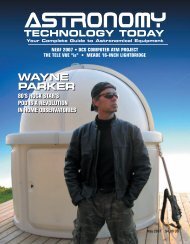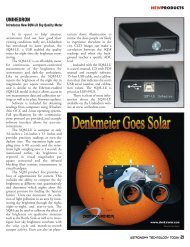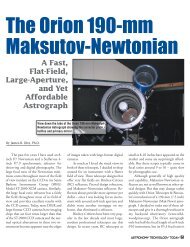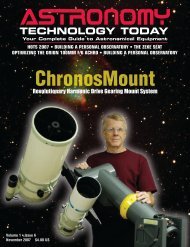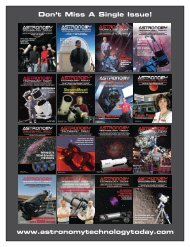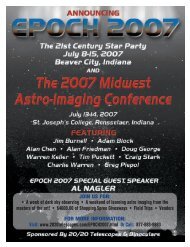Mike Jones article.qxd:Layout 1 - Astronomy Technology Today
Mike Jones article.qxd:Layout 1 - Astronomy Technology Today
Mike Jones article.qxd:Layout 1 - Astronomy Technology Today
Create successful ePaper yourself
Turn your PDF publications into a flip-book with our unique Google optimized e-Paper software.
BAFFLE OPTIMIZATION FOR CASSEGRAIN TELESCOPESDon’t Buy DisappointmentThe Half Hitch Delivers Solid SatisfactionShake-free focusing and trackingfrom a mount weighing justfive and a quarter pounds• CNC machined and anodized• Backlash-free motion controls• No clutches or counterweights• Vise-like dovetail system included• Two-axis balancing keeps your scope on target without heavy friction• Disc brake for changing eyepieces• Rigid cross-braced design• Precision encoder installation and folding DSC bracket• Excellent tripod clearance means no column extension needed• Preloaded Timken bearings mean no slop• Centerline loading for superior stability andperformance from your tripodDon’t skimp on one of the most critical components in yourtelescope. Get the most from your expensive premium optics.www.halfhitchtelescope.comIntroducing the TrueRCastrograph series fromDeep Sky InstrumentsRC10 (uncorrected): $4,995 (Introductory price)RC10C (corrected): $ 5,995 (Introductory price)We offer two versions in theTrueRC series depending on yourrequirements. The RC10 providesRitchey-Chrétien performance freefrom coma, spherical aberration andfirst-order astigmatism. The RC10Cadds a corrector/field flattener to removethird-order astigmatism andflatten the field for excellent star imageson even today's largest CCD cameras. Both astrographs featureoptics by Star Instruments, maker of RC optics for over 30 years.535 Pine Road, Suite 204 • Newnan, Georgia 30263www.deepskyinstruments.comlength (call this the variable “TBS”) is selected.A good starting value is about onethirdof the semi-diameter of thesecondary mirror determined by the approximationgiven above. A dummy surfaceat the rear of the secondary baffle isincluded in the raytracing.Ray 1 (shown in blue in Figure 2) istraced first. Ray 1 is the ray from the lowestsemi-field angle, traced in an ascendingdirection to the upper rim of the primarymirror P 1-1 , then to the rear plane of thesecondary baffle P 1-2 , and then to thesecondary mirror P 1-3 . It then interceptsthe plane at the front of the primary baffleat P 1-4 , returns to and through theprimary surface at P 1-5 , and terminatesat the uppermost point in the image planeP 1-6 . This ray precisely defines the diameterof the Cassegrain secondary requiredfor 100 percent field illumination, and theminimum diameter of the hole throughthe Cassegrain primary mirror. The programmodifies the initial Cassegrain designmodel with the new values for thesecondary and primary hole diameters.Ray 1 segment (P 1-3 – P 1-6 ) is used forbaffle optimization.Ray 2 (shown in red in Figure 3) istraced next. Ray 2 is sloped downwardfrom the upper point in semi-field angle,but instead of being traced from the sky, itbegins at the upper point on the rear ofthe secondary baffle determined byRay 1 (P 1-2 in Figure 2 and P 2-1 in Figure3, which have identical coordinates).It descends to the primary mirror intersectionP 2-2 , then reflects to the frontplane of the primary baffle tube P 2-3 ,andthen to secondary mirror P 2-4 . Ray 2then proceeds to the lowest point in theimage at P 2-5 . Ray 2 segment (P 2-2 –P 2-4 ) determines the taper of the primarybaffle as well as being used for baffleoptimization.Ray 3 (shown in green in Figure 4) isthe cross-ray from the upper point P 3-1on the upper rear of the secondary baffletube to the lower point P 3-3 in the image.Ray 3 is not actually raytraced; its direc-54 <strong>Astronomy</strong> TECHNOLOGY TODAY



